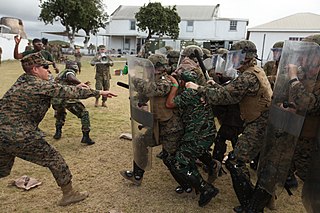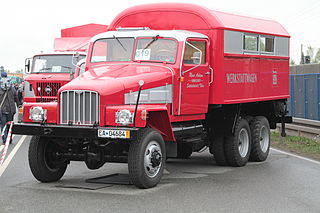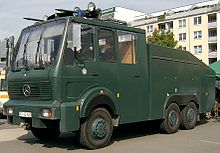GSG 9 der Bundespolizei, formerly Grenzschutzgruppe 9, is an elite special forces unit of the German Federal Police (Bundespolizei) to combat terrorism and violent and organized crime. In addition to its headquarters location in Sankt Augustin-Hangelar near Bonn, it has a second location in Berlin. Since 1 August 2017, it has been subordinate to the Federal Police Directorate 11. The state police (Landespolizei) maintain their own regional tactical units known as the Spezialeinsatzkommando (SEK). The GSG 9 unit is made up of approximately 400 highly trained police officers and the identities of GSG 9 members are classified. The specialised unit operates not only within Germany on a federal level, but also safeguards German interests located worldwide, such as embassy property and personnel. Alongside the KSK military special forces of the German Armed Forces (Bundeswehr), the GSG 9 can also be authorized to rescue citizens abroad in hostage situations.

A water cannon is a device that shoots a high-velocity stream of water. Typically, a water cannon can deliver a large volume of water, often over dozens of meters. They are used in firefighting, large vehicle washing, riot control, and mining. Most water cannons fall under the category of a fire monitor.

Riot control measures are used by law enforcement, military, paramilitary or security forces to control, disperse, and arrest people who are involved in a riot, unlawful demonstration or unlawful protest.

The European Gendarmerie Force (EUROGENDFOR) is a European rapid reaction force composed of elements of several European police and gendarmerie forces. EUROGENDFOR is tasked with performing policing tasks within the scope of crisis management operations.

Bundesgrenzschutz is the former name of the German Bundespolizei. Established on 16 March 1951 as a subordinate agency of the Federal Ministry of the Interior, the BGS originally was primarily focused on protecting the West German borders. During their early days, BGS units had military structures, training and equipment. The law enforcement officers legally had military combatant status until 1994. A major part of the early BGS personnel joined the newly founded German Armed Forces (Bundeswehr) in 1956 and thus significantly contributed to West Germany's rearmament. The BGS was renamed to Bundespolizei on 1 July 2005. The change of name did not have any effect on the legal status or competencies of the agency, but rather reflects its transition to a multi-faceted police agency with control over border, railway and air security.

Riot police are police who are organized, deployed, trained or equipped to confront crowds, protests or riots.

The Federal Police is the national and principal federal law enforcement agency of the German Federal Government, being subordinate to the Federal Ministry of the Interior, Building and Community. The Federal Police is primarily responsible for border protection and railroad and aviation/air security. In addition, the agency is responsible, among other tasks, for the protection of federal constitutional bodies. It provides the federal alert police and GSG 9 special police unit, which can also be used to support the federated states of Germany. Ordinary police forces, meanwhile, are under the administration of the individual German states (Bundesländer) and are known as the Landespolizei. In addition to the Federal Police, the Federal Criminal Police Office and the German Parliament Police exist as further police authorities at the federal level.

The Bereitschaftspolizei, BePo, are the support and rapid reaction units of Germany's police forces. They are composed of detachments from the Federal Police and the State Police forces of Germany.

Law enforcement in Germany is constitutionally vested solely with the states, which is one of the main features of the German political system.

The Wasserschutzpolizei is the river police that patrols the waterways, lakes and harbours of Germany around the clock. The WSP are part of the Landespolizei. The Federal Police maintains 16 patrol craft and helicopters are part of the Coast Guard (Küstenwache) and assigned to coastal BPOL stations. The watercraft include six offshore patrol vessels, e.g. those of the Bad Bramstedt class, as well as a number of fast inshore vessels and one tugboat.

Non-military armoured vehicles are armoured vehicles used outside professional armed forces. While primarily invented and used for defense/internal conflicts from an equally well armed organized force, armour technology has found a number of other uses outside of this military context.
The Federal Police is the national and principal law enforcement agency of Austria. The Federal Police was formed in July 2005 as one formal unit of police. In 2005, the Federal Police replaced the Austrian Federal Gendarmerie, which policed most of the country, and the Polizei which policed Austria’s major urban centres such as Vienna, Salzburg and Graz. The Federal Police also serves as Austria’s border control agency. The Federal Police works in partnership with the 19 municipal police agencies and other law enforcement agencies in Austria.

The TM-170 is an armored personnel carrier was announced for the first time in 1978 and entered production in 1979. It was originally designed primarily for use as an APC or an internal security vehicle, but could be adapted for a wide range of other roles.

Berlin is a city-state and the capital of the Federal Republic of Germany.

The IFA G5 is an East German three-axle truck produced by IFA from 1952 to 1964.

The TOMA is an armored water cannon designed for riot control by Turkish companies Otokar, BMC, Katmerciler, Moğol Makina and Nurol Makina.

Crowd control in Jammu and Kashmir is a public security practice to prevent and manage violent riots. It is enforced by police forces through laws preventing unlawful assembly, as well as using riot control agents such as tear gas, chili grenades, and pellet guns.

Bundespolizeidirektion 11 or BPOLD 11 is the unified command of the units with special tasks of the German Federal Police.

The Wasserwerfer 10000 is a water cannon used for riot control developed by Rosenbauer on the Mercedes-Benz Actros chassis for the Federal Police (Bundespolizei) and Bereitschaftspolizei in Germany. Named for its 10,000 litres (2,600 US gal) water capacity, it is the successor to the Wasserwerfer 9000.






















